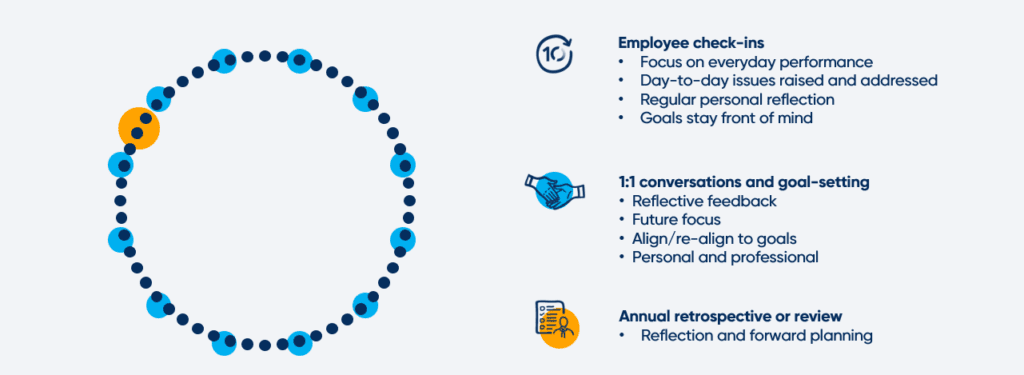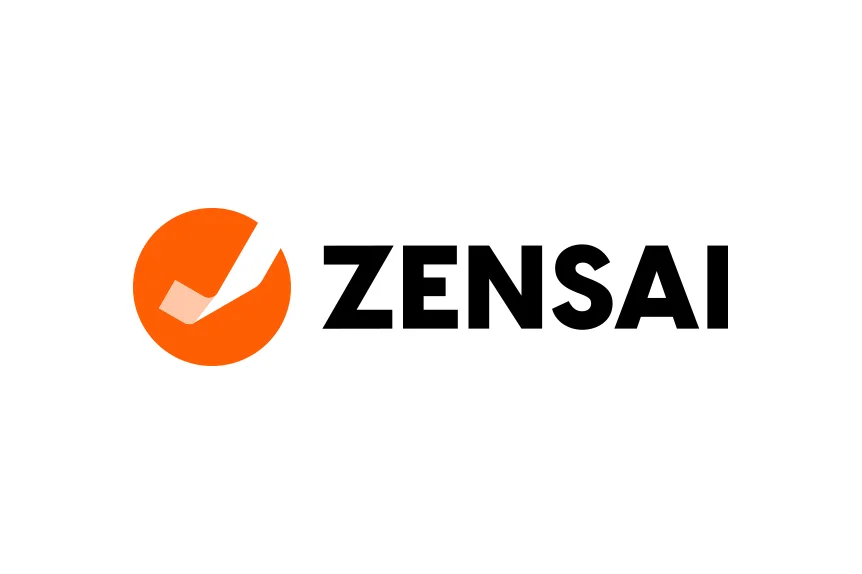Managing employee performance is a leader’s central responsibility. That’s as true for small team managers as it is for people in charge of whole departments or divisions. So, what types of performance conversation can you have with your people, and why do we need to identify the different approaches?
We’ve already talked about best practice for discussing staff performance before. But, today, we wanted to go into more detail on the different options available to you.
How do we talk about employee performance?
First off, you might be wondering what we mean by performance conversations. After all, we’re historically not huge fans of traditional performance reviews. So, what are we talking about?
At its most basic, a performance conversation is a 1:1 discussion between an employee and their manager about their work output. It should address what they’ve achieved, how they can improve, and what support they need from you. So, in that sense, a traditional annual review is a kind of performance conversation. It just happens to be a highly flawed approach.
So, the question is, how can you have different types of performance conversations while making sure they’re effective?
Performance management is a two-way discussion
The goal of these discussions should be to reach a shared understanding with your employee. But that doesn’t mean it’s their job to sit and listen to you tell them how things are. These are ultimately discussions, after all. So, there should be some back-and-forth beyond “Yes sir,” and “I understand.”
In these meetings, an employee must contextualize their performance. Talking to employees directly about their work lets them highlight their achievements, but also talk about their failures. The other is to give employees a voice.
Two-way feedback lets employees flag productivity blockers and more serious issues. It even lets them weigh in on the latest developments in your workplace, like a new office layout. But remember, it’s not enough just to listen to your people. You have to work at turning what they say into actionable insight, then follow through with it.
Have these types of performance conversation face-to-face
Platforms like ours have features to help automate different types of performance conversations. But, as handy as this can be, try not to go overboard. Direct interaction is an invaluable tool for managing your people. And that’s doubly true for your remote or hybrid staff, even if it’s a video call.
Sure, it means you both have to find times in your schedules for a sit-down chat. But that means you both have time to talk things out and ask questions. And, of course, it means managers get a direct read on their employees, to see how they take critical feedback.
Ongoing, timely feedback is key
The biggest downfall of traditional performance reviews is their infrequency. It’s worth having 1:1s with your people more than a couple of times a year. But you should also go further than that with weekly feedback.
No, we’re not suggesting you have 1:1s with each team member every week. Otherwise, that would be all you’d do. We’re saying that, for all the different kinds of performance conversation, they still need a bridge. And, ideally, you should be exchanging feedback on a weekly basis.
According to Gallup, employees who get feedback weekly instead of annually are:
- More than five times more likely to agree they receive meaningful feedback.
- Over three times as likely to agree they’re motivated to do outstanding work.
- Nearly three times as engaged in their role.
Types of conversations about performance
All in all, there are nine types of performance conversation worth covering. These can be scheduled as part of your regular performance management cycle, or ad-hoc. And, seeing as we’re highlighting the benefits of weekly feedback, let’s start with check-ins.
4 types of scheduled performance conversations

1. Weekly check-ins
A check-in is pretty much what it sounds like. It’s a light-touch way of seeing how your people are doing. Our check-in specifically is an asynchronous tool, allowing users to submit and review updates in a matter of minutes. That way, they can be implemented without disrupting your team’s schedule.
The first part of our check-in is a set of questions personalized for each employee. These questions inquire about their recent experiences, level of engagement, and overall wellbeing. The second part is goal-tracking, using either SMART Goals or OKRs. This way, every week, you get a combination of sentiment summary and progress update.
2. 1:1 conversations
When it comes to the different types of performance conversation, many of them could be 1:1s. So, it’s worth looking at the benefits of sitting down for a one-on-one chat. First off, it demonstrates to employees that they matter. Taking the time to talk about their role with them shows their contributions are a priority.
Second, 1:1 conversations encourage honesty by providing privacy. For employees, performance conversations can be especially nerve-wracking. They’re expected to highlight their worth and defend their shortcomings. Doing that in front of a group of people would make it even more stressful. When you have a good working relationship with your team, they’ll find it easier to talk to you in private.
A general 1:1 should cover all the bases. It should address their productivity and wellbeing, as well as a progress report on their goals. Those goals can then be aligned (or realigned) with business objectives. These 1:1s are also an ideal place to talk about personal or professional development.
3. Goal-setting sessions
Goal-setting meetings are the time for everyone to get on the same page. While they could be 1:1, it’s more likely to be a group meeting full of individual actions. Everyone working on the project gets an update on what everyone else has been doing or will be doing.
Although these may be group performance conversations, individual employees are expected to summarize their progress and provide a clear picture of their next steps.
4. Retrospectives and review performance conversations
These are perhaps the most classic types of performance conversation on the list. However often you have them, these meetings are traditionally viewed as the crux of performance management. So, as a manager, it’s vital you remember a few key points:
- Ignore the “Sandwich method.” Clearly delineate your positive and negative feedback.
- Avoid recency bias by using check-ins as documentation for feedback and performance.
- Achieve a shared understanding and establish the employee’s next steps together.
5 types of ad-hoc performance conversations
1. Underperformance meetings
More than all the other types of performance conversation, this is the one people dread. The only thing worse than having to talk to an employee about their poor performance is to be the employee getting slated.
We can’t overstate the importance of active listening here. It’s easy to assume an underperforming employee is simply lazy, but there are often more complex issues at play:
- A lack of engagement.
- Any form of poor wellbeing.
- Out-of-work obligations or stressors.
- A disruptive work environment.
- Workplace conflict.
So, before you reach for disciplinary action, try to figure out what support they might need. We all have our off weeks. Having a chat will help you figure out if an employee’s poor performance is a habit or recent development. As with general review meetings, the goal should be to share an understanding and establish the next steps.
2. Overperformance meetings
Then, on the other hand, we have overperformance meetings. This type of performance conversation can be a good thing or bad, depending on the employee. The first thing you’ve got to figure out as their manager is whether they’re burning themselves out to deliver these results.
If they aren’t, great. You get to hype them up by telling them what amazing work they’re doing. This is a great time to check up on what their professional goals are if you don’t know already. Then it’s a case of enabling them to flourish. Promote them, make them a mentor, and have them work closely with other departments.
If, on the other hand, they’re burning out, then you need to get them to slow down. Otherwise, you risk losing them entirely. Check if they’re using their assigned breaks, or taking their vacation days. But remember, overworking tendencies are usually deeply ingrained, so don’t expect to fix them with one conversation.
3. Project reviews
Whether you use check-ins and goal-tracking or not, sometimes, it’s worth having a sit-down project review. When a big project is steamrolling forward, you need to be able to stop and make sure everything is on-track. It’s not just about making sure goals are being met, but also that they still align with business objectives. The last thing you need is your key results for a major objective working against each other.
4. Ad-hoc catch-ups
Ad-hoc catch-ups are conversations prompted by your employee. Usually, it’s because they want to raise an issue privately. So, always go in ready to listen, even if you already know what it’s about. These can often be about aspects of performance. But they can also be about sensitive personal issues, like an emerging health problem or harassment at work.
5. Pay review meetings
It’s easy to talk about how there are more important things than money when you’re pulling down a manager’s salary. But, if there’s one thing we’ll probably see more of in the cost-of-living crisis, it’s pay review meetings.
It’s your job to listen as the employee makes their case for a raise. They’ll cite their contributions and hard work, and you need to respond fairly. With financial wellbeing becoming more of a focus area for employees, it’s imperative you properly compensate your people.
All types of performance conversation have their place in your work culture. It’s all about finding the right balance, without disrupting your employees’ work schedules.










